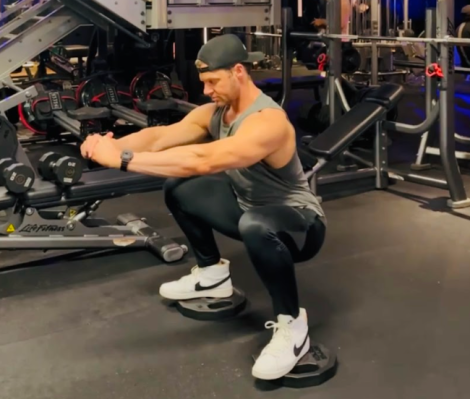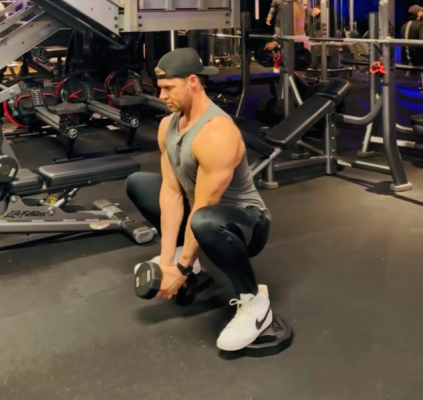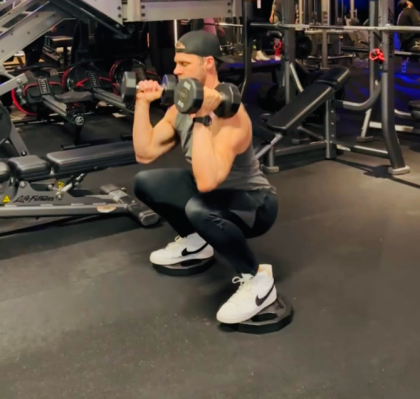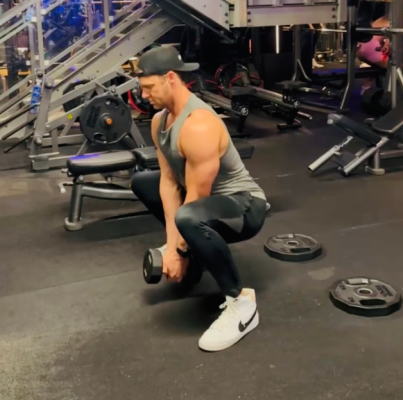The sumo squat is an excellent exercise for strengthening and toning your glutes and inner thighs, while also improving hip mobility. By slightly modifying the traditional squat, the sumo squat works your muscles in a unique way. Incorporating this squat variation into your workout routine can be seriously beneficial.
This sumo squat got its name because it requires you to stand in a traditional sumo wrestler stance.
“This variation differs from the traditional squat by adopting a wider stance with the feet turned outward,” says Joey Thurman, CPT, certified personal trainer, author, and founder of Fun Fitness Bros. “The sumo squat is an exceptional exercise for those looking to enhance their lower-body strength.”
Whether you’re a new or seasoned squatter—or anywhere in between—there are several variations of the sumo squat to challenge your body.
“It’s commonly performed with a weight held near your shins or feet. The weight can assist in achieving greater depth due to the open hip position and the downward pull of the weight,” Thurman says.
Having proper form is the key to getting the maximum benefits and preventing injury. Let’s first nail down how to do the sumo squat. Then we’ll dive into sumo squat muscles worked, benefits, common mistakes, and variations to try.
How to do a sumo squat with perfect form every time
You should first make sure you nail down proper sumo squat form using just your body weight before adding weights such as a kettlebell, barbell, or dumbbell. (If you need a refresher on how to squat with correct form, we’ve got you covered.)

- Stand with your feet just slightly wider than hip-width distance, arms down by your sides.
- Point your toes outward at about a 45-degree angle.
- Keeping your chest tall, bend your knees as you push your hips back and shift your weight onto your heels as you squat down. Pretend you’re about to sit in a chair.
- Extend your arms out in front of you as you squat down.
- Lower down as far as comfortable, or until your thighs are parallel with the floor.
- Push through your heels to come back up into the standing position.
- Repeat for 2 to 3 sets of 8 to 12 reps.
Tip: Placing weight plates underneath your heels (like Thurman demonstrates) can help you achieve a deeper squat depth.
Sumo squat muscles worked
“Sumo squats are a great movement to improve your leg strength and increase leg muscle mass,” says Grayson Wickham, DPT, CSCS, physical therapist and founder of Movement Vault.
Sumo squat muscles worked include the same as the traditional squat. However, due to the foot placement, there’s more emphasis on certain muscles.
- Glutes: Your glute muscles (gluteus maximus, medius, and minimus) are one of the main muscles worked when doing sumo squats. (Try these at-home glute exercises in addition to sumo squats if you want to seriously sculpt your backside.)
- Adductors: A 2021 study in the International Journal of Environmental Research and Public Health found the sumo squat works your adductors (inner thighs) better than the traditional squat because of its wide stance and toe angle.
- Quadriceps: The large muscles at the front of your leg, the quadriceps (quads) are strengthened during the sumo squat. There’s an emphasis on the outside portion of this muscle, called the vastus lateralis, during the sumo squat, according to the International Journal of Environmental Research and Public Health study.
- Hamstrings: This large muscle at the back of your leg gets a good workout during the sumo squat.
- Calves: Your calf muscles help to stabilize your foot and ankle during the sumo squat.
- Core: It’s not just your lower body that gets a workout during the sumo squat. Because your trunk stays upright, your abdominals work to keep your body stabilized throughout the exercise.
The benefits of sumo squats that’ll convince you to add them to your workouts
Here are six reasons why the sumo squat deserves a spot in your exercise routine.
1. They strengthen your inner thighs
“The sumo squat’s wider stance and turned-out feet position engages the inner thigh muscles adductors, in addition to targeting the glutes and quads,” Thurman says. This is backed up by a small 2017 study in the Journal of Strength and Conditioning Research2.
As noted above, this powerhouse move also works your hamstrings, calves, and core.
2. They improve hip mobility
“The sumo squat helps improve hip flexibility and range of motion due to the open hip angle required,” Thurman says.
3. They don’t strain your back as much as other variations
If you’re holding a weight while performing sumo squats, you would hold the weight lower and closer to your body’s center of gravity, according to Thurman.
“There’s less strain on the lower back compared to other squat variations or when the weight is held up high,” Thurman says.
Sumo squats also strengthen your core muscles, which help protect and support your back.
4. They decrease stress on your ankle joint
For those who have reduced ankle motion, either due to an injury or calf tightness, the sumo squat may be a better option over the traditional squat.
“The main benefit of the sumo squat versus a regular-stance squat is that it decreases the demands on your ankle mobility, specifically you don’t need as much ankle dorsiflexion,” Wickham says.
5. They’re a functional exercise
Because the sumo squat works the same muscles that are used for actions like sitting down, standing up, walking up stairs, and stepping over objects, it makes doing those everyday activities easier.
Sumo squat gains can also carry over into sports, as stronger leg muscles may mean improvement in athletic performance with running, jumping, and playing basketball or tennis.
6. They’re a versatile exercise
“The sumo squat can be performed with various equipment—dumbbells, kettlebells, barbells— or with bodyweight alone, making it suitable for a wide range of fitness levels,” Thurman says.
“The sumo squat is an exceptional exercise for those looking to enhance their lower-body strength.” —Joey Thurman, CPT
Sumo squat variations to mix things up
Once you’ve nailed the basic sumo squat, try out one (or all!) of these sumo squat variations.
1. Sumo squat with weight
Use a kettlebell or dumbbell to add some resistance to this move. Adding weight not only makes your muscles work harder, but it also helps you squat down further, according to Thurman. This improves hip mobility and works your muscles in a greater range of motion.

- Stand with your feet just slightly wider than hip-width distance.
- Point your toes outward at about a 45-degree angle.
- Hold a kettlebell or dumbbell with both hands in front, with your arms straight down.
- Keeping your chest tall, bend your knees as you push your hips back and shift your weight onto your heels as you squat down. Pretend you’re about to sit in a chair.
- Lower down as far as comfortable, or until your thighs are parallel with the floor.
- Push through your heels to come back up into the standing position.
- Repeat for 2 to 3 sets of 8 to 12 reps.
2. Sumo squat with overhead press
This is truly a full-body exercise, as it works your shoulders, back, and arms in addition to your legs and core. Start with a lighter weight and gradually work your way up.

- Stand with your feet just slightly wider than hip-width distance.
- Point your toes outward at about a 45-degree angle.
- Hold a dumbbell in each hand. Rack the weights up by your shoulders. Your elbows should be facing the wall in front of you.
- Keeping your chest tall, bend your knees as you push your hips back and shift your weight onto your heels as you squat down. Pretend you’re about to sit in a chair.
- Lower down as far as comfortable, or until your thighs are parallel with the floor.
- Push through your heels to come back up into the standing position.
- As you stand up, push both your arms overhead.
- Return to the starting position.
- Repeat for 2 to 3 sets of 8 to 12 reps.
3. Sumo squat with hop
The hop adds a plyometric component (an explosive move that builds strength, power, balance, and agility) that challenges your legs and cranks up your heart rate. It also works your inner thighs more than the regular sumo squat.

- Stand with your feet just slightly wider than hip-width distance.
- Point your toes outward at about a 45-degree angle.
- Hold a kettlebell or dumbbell with both hands in front, with your arms straight down.
- Keeping your chest tall, bend your knees as you push your hips back and shift your weight onto your heels as you squat down. Pretend you’re about to sit in a chair.
- Lower down as far as comfortable, or until your thighs are parallel with the floor.
- Push through your heels and do an explosive hop back up into the standing position. Land with your knees slightly bent.
- Repeat for 2 to 3 sets of 8 to 12 reps.
Don’t make these sumo squat common mistakes
Watch yourself in the mirror and make sure you aren’t making these common sumo squat form mistakes.
1. You have too narrow of a stance
Unlike a traditional squat in which your feet are slightly wider than shoulder-width apart, your feet should be slightly wider than hip-width distance apart in the sumo squat.
“Not adopting a wide enough stance reduces the effectiveness of the exercise and the involvement of the targeted muscles,” Thurman says.
2. You round your back
Rounding your back and letting your trunk fall forward is another common form mistake.
“This can put unnecessary strain on the spine. Keeping a neutral spine throughout the movement is crucial,” Thurman says.
Hunching forward could “also be a sign of poor hip mobility or core stability,” Wickham says. Focus on keeping your trunk upright throughout the sumo squat.
3. Your toes aren’t turned out enough
Unlike the traditional squat in which your toes are only turned out slightly, with the sumo squat they should be turned out to 45 degrees. Doing this also allows for your knees to track properly to maximize the benefits of this exercise.
“Your feet should be turned outward to a comfortable degree to allow for proper knee tracking and to engage the desired muscle groups effectively,” Thurman says.
Your knees should be tracking over the middle of your feet, according to Wickham.
4. You don’t squat low enough
You should aim to squat until your hip crease is below your knee—or at least until your thighs are parallel to the ground.
“Failing to achieve adequate depth can limit the engagement of the glutes and hamstrings,” Thurman says.
Don’t panic if you can’t go that low with proper form—just go as far as you can and work yourself lower as your strength and mobility improves.
FAQ
1. Are sumo squats better than regular squats?
“No exercise is truly better than the other. It all depends on what your goal is for an exercise,” Wickham says. “If you have the proper hip and ankle mobility needed, I like regular-stance squats, as they work your hips and ankles through a greater range of motion and have more carry over to other movements.”
Want to target your inner thighs? Add the sumo squat into your exercise routine. Doing both traditional squats and sumo squats gives you the best of both worlds.
2. Should you do sumo squats every day?
“While sumo squats are beneficial, doing them every day can lead to overtraining and muscle imbalances,” Thurman says. “Your muscles need time to recover and rebuild stronger. Incorporating rest days or alternating with other exercises can prevent overuse injuries and promote balanced muscle development.”
Constant high-intensity training without getting enough recovery can worsen your performance and lead to injuries, according to Thurman.
“It’s crucial to listen to your body and include variety in your workout routine to ensure overall fitness and health,” he says.
3. How long should you hold a sumo squat?
“In the sumo squat, the focus is typically on the movement rather than holding a position,” Thurman says. “However, incorporating a 1- to 2-second pause at the bottom of the squat can increase muscle activation and strength gains. Ensure that you maintain proper form throughout.”
Well+Good articles reference scientific, reliable, recent, robust studies to back up the information we share. You can trust us along your wellness journey.
-
Coratella G, Tornatore G, Caccavale F, Longo S, Esposito F, Cè E. The Activation of Gluteal, Thigh, and Lower Back Muscles in Different Squat Variations Performed by Competitive Bodybuilders: Implications for Resistance Training. Int J Environ Res Public Health. 2021 Jan 18;18(2):772. doi: 10.3390/ijerph18020772. PMID: 33477561; PMCID: PMC7831128. -
Slater LV, Hart JM. Muscle Activation Patterns During Different Squat Techniques. J Strength Cond Res. 2017 Mar;31(3):667-676. doi: 10.1519/JSC.0000000000001323. PMID: 26808843.
